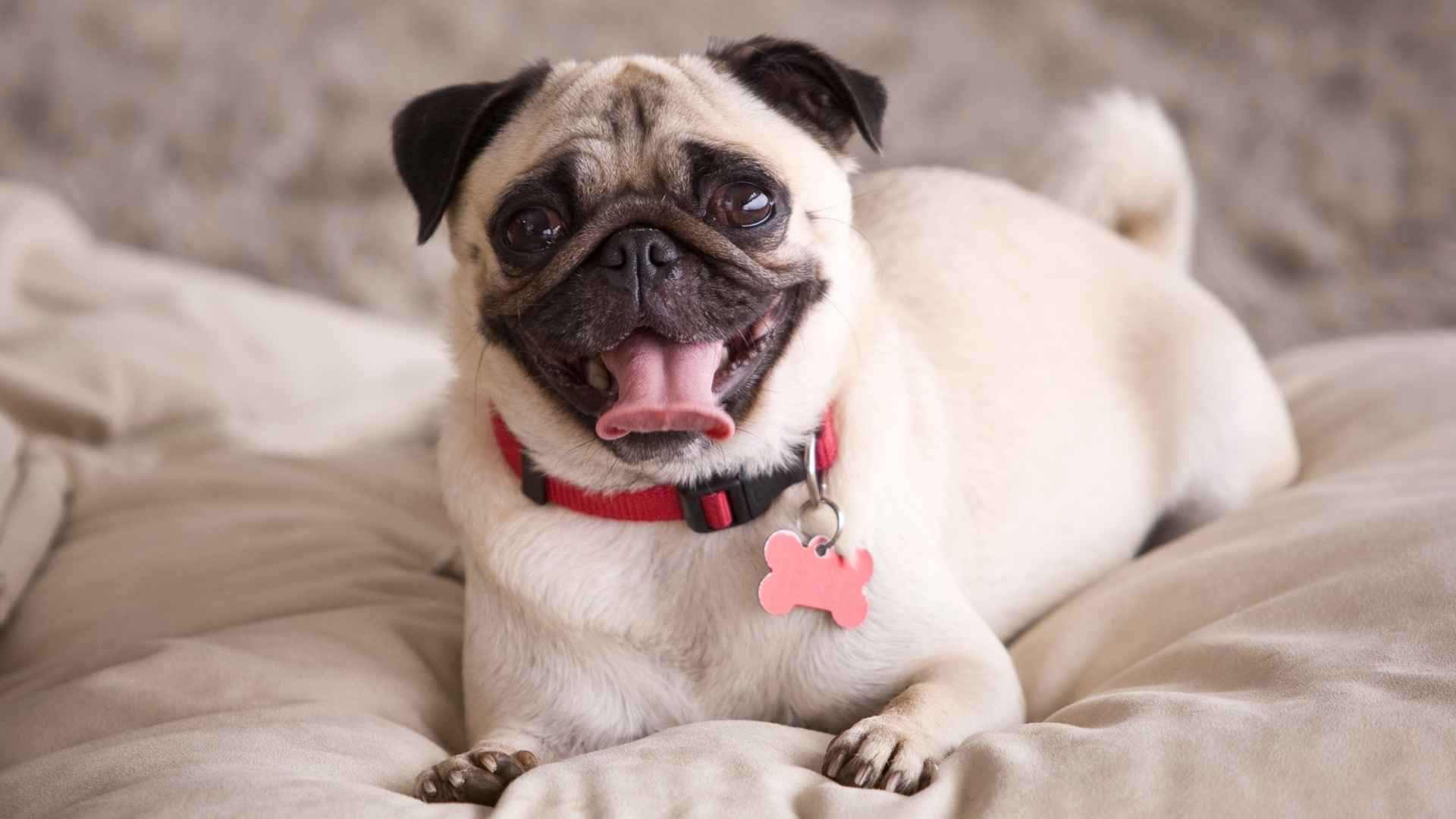Wrinkles never looked so good. In the world of dogs, folds and creases aren’t a flaw—they’re a feature! The most wrinkly dog breeds wear their extra skin like badges of honor, turning heads and melting hearts wherever they go. From the noble Chinese Shar-Pei with its ancient lineage to the ever-goofy Bulldog with its squishy face, these pups bring personality and charm in every soft, saggy fold.
But don’t be fooled by the cuteness—those adorable wrinkles come with care needs, too. Keeping their skin clean and healthy is part of the package deal. Whether you’re drawn to their quirky expressions or their cuddle-ready rolls, wrinkly dogs have a way of making an unforgettable impression.
Ready to meet the crinkled canines that might just become your next best friend? Let’s dive into the world of the most wrinkly dog breeds and uncover what makes each of them a lovable, fold-filled companion.
Most Wrinkly Dog Breeds
1. Bullmastiff
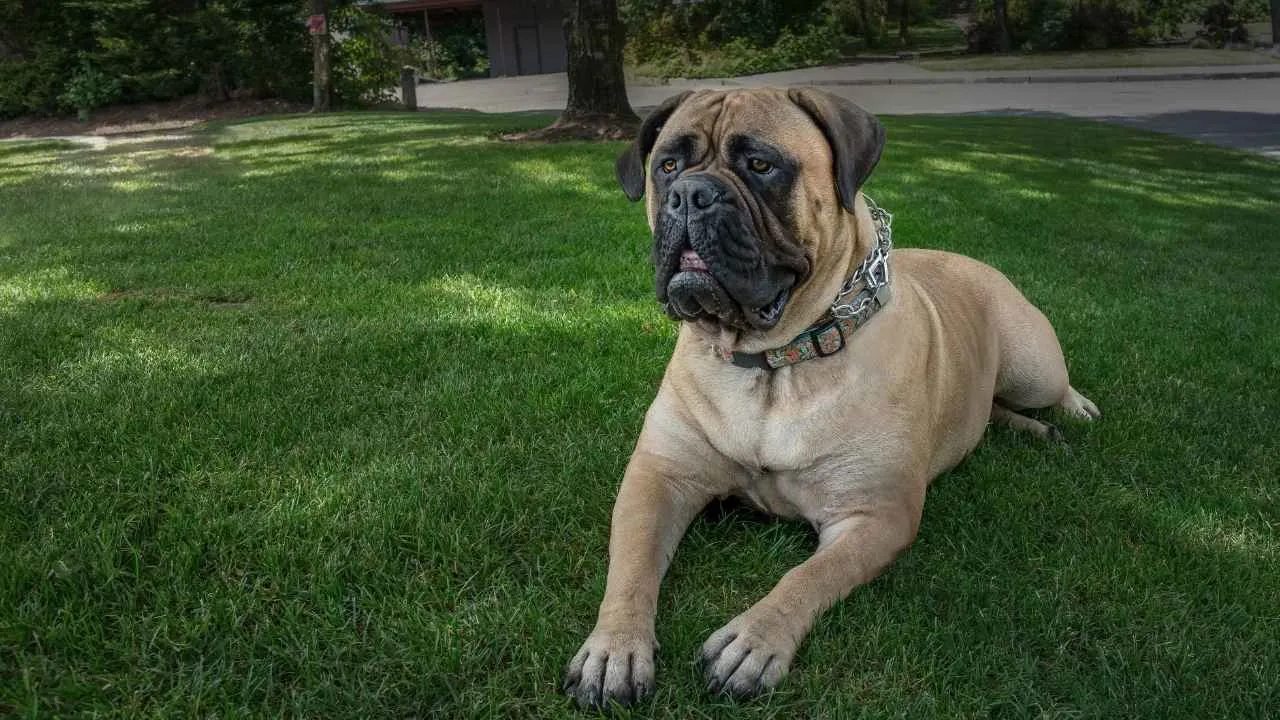
Bred in 19th-century England, Bullmastiffs were developed by gamekeepers to protect large estates from poachers. A cross between the English Mastiff and the Old English Bulldog, they were known as the Gamekeeper’s Night Dog—strong, silent, and incredibly loyal.
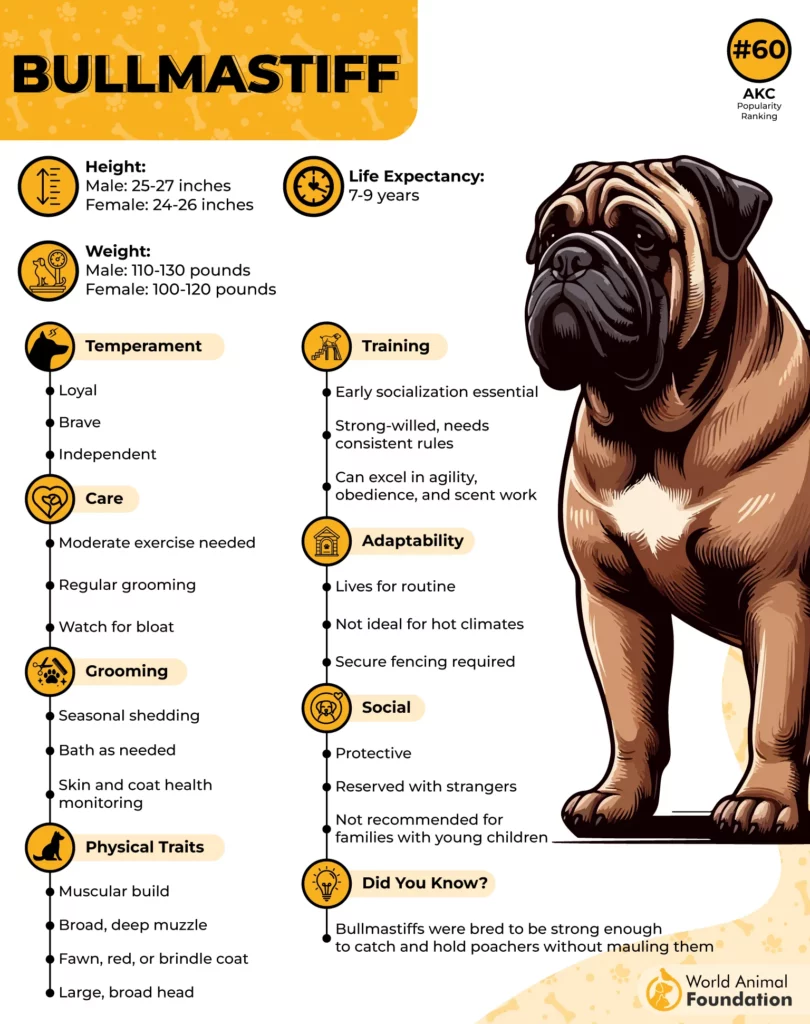
Bullmastiffs are large, powerfully built dogs with a compact yet muscular frame. While they share Molosser traits, they’re more agile than their size suggests.
Males: 25–27 inches tall, 110–130 lbs
Females: 24–26 inches tall, 100–120 lbs
Lifespan: 7–9 years
Their wide chest, square head, short muzzle, and deep hazel eyes make them look as tough as they are sweet.
Grooming Essentials
Bullmastiffs have short coats that shed seasonally, so regular grooming is important to keep their fur healthy and manageable. While their grooming needs are not excessive, their coat still requires consistent maintenance, including brushing to control shedding and occasional baths using a dog-safe shampoo. Maintaining a proper grooming routine not only keeps their coat in good condition but also helps reduce odors and dirt buildup.
Owners should pay close attention to the condition of their bullmastiff’s skin and coat, monitoring for signs of dryness or excess oil. Any noticeable imbalance may be a sign of allergies, dietary issues, or underlying health concerns and should be addressed with a veterinarian. Feeding a balanced diet rich in nutrients is also essential for promoting a healthy coat and skin.
In addition to coat care, bullmastiffs may need extra attention around their jowls. These areas can collect drool and bits of food, potentially leading to irritation or bacterial buildup if not cleaned regularly. A daily wipe-down of the jowls with a clean cloth can help maintain hygiene and prevent skin issues.
Health Concerns to Watch For
Bullmastiffs are prone to several hereditary and age-related health conditions. Owners should schedule regular vet checkups to stay ahead of potential problems.
Common Health Issues Include:
Hip & Elbow Dysplasia – causes joint pain, lameness, and stiffness
Entropion – an eyelid disorder leading to irritation or eye damage
Hypothyroidism – results in weight gain, fatigue, and skin issues
Progressive Retinal Atrophy (PRA) – gradual vision loss
Gastric Dilatation-Volvulus (GDV) – a life-threatening bloating condition
2. Neapolitan Mastiff
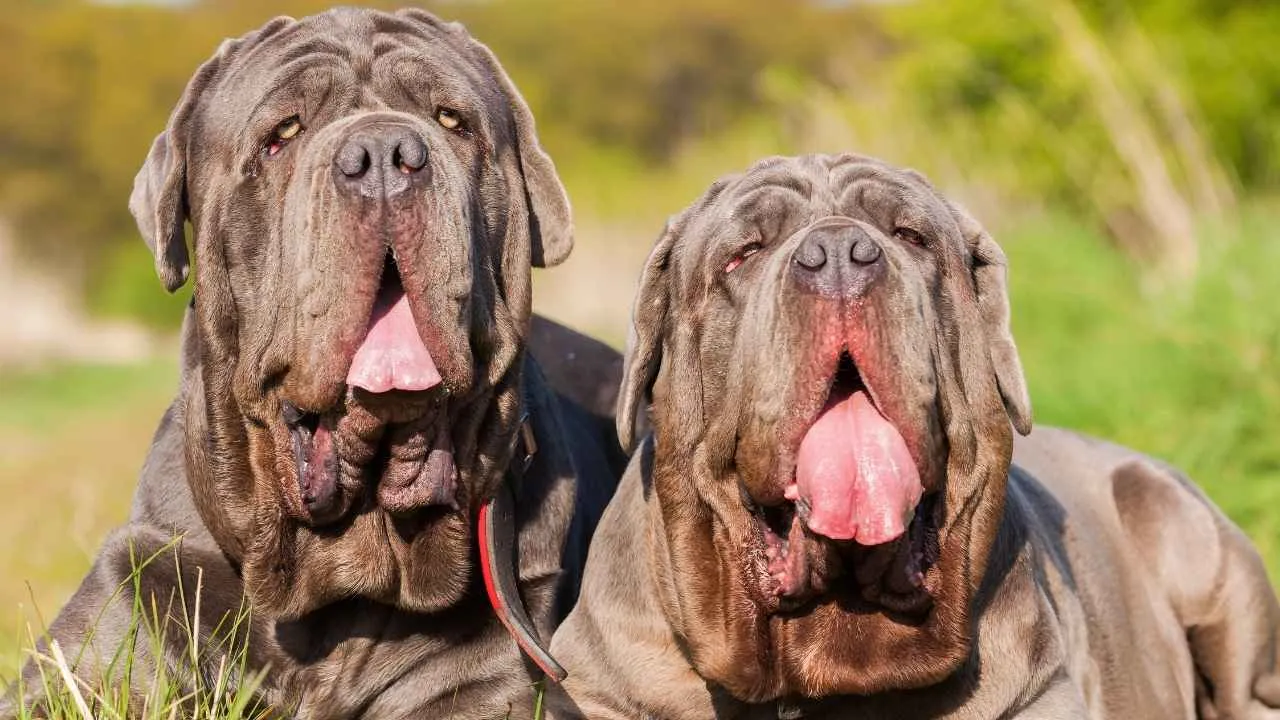
Historically bred for war and now adored as a family protector, the Neapolitan Mastiff—also known as the Mastino—is a majestic, wrinkled behemoth with a heart of gold. Their intimidating look hides a calm and affectionate personality that thrives on loyalty and companionship.
With their massive size, soulful eyes, rolling gait, and characteristic wrinkled appearance, this breed has a unique, almost mythical look.
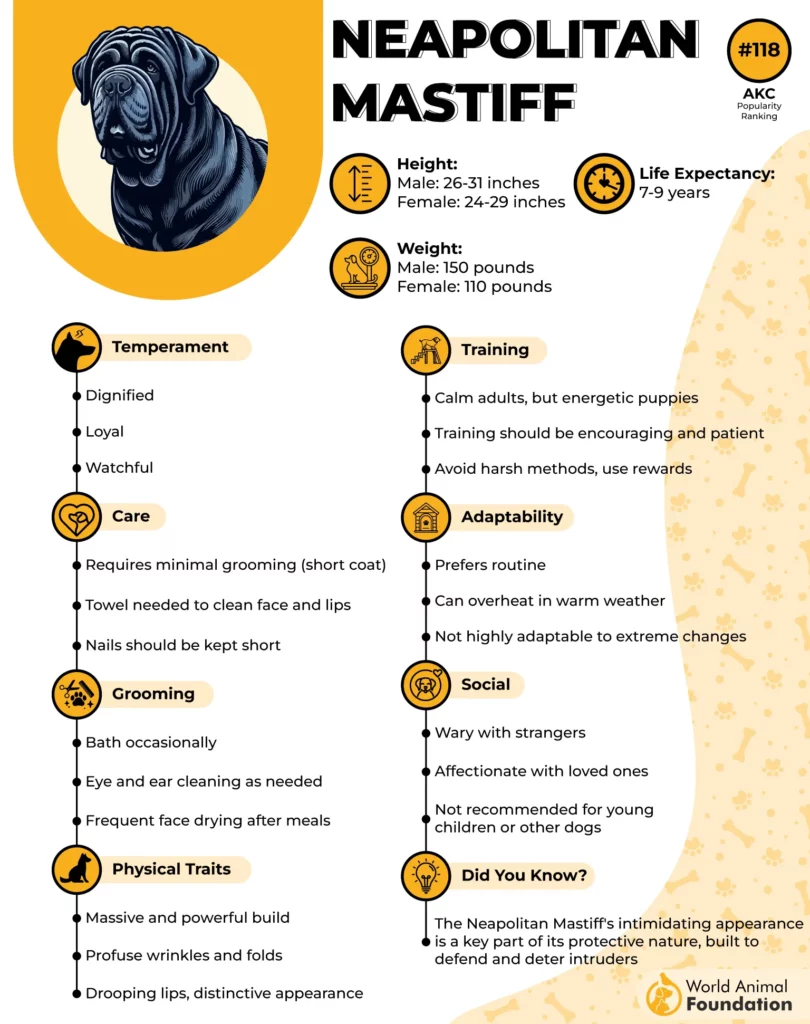
Caring for a Neapolitan Mastiff’s wrinkles requires daily effort. Each skin fold must be carefully cleaned and dried to prevent trapped moisture, which can lead to skin irritations or infections. Special attention should also be given to their jowls, which tend to collect drool and food debris. Keeping a cloth handy to wipe their face regularly can go a long way in preventing issues.
Grooming Needs
Bathing your Neapolitan Mastiff once or twice a month is usually sufficient, using a gentle, dog-safe shampoo and conditioner. However, dogs with sensitive skin or allergies may need more frequent baths. It’s important to start grooming routines early—introducing your dog to baths with calming tools like lick mats and soothing shampoos can help create a stress-free experience.
Common Health Concerns
Cherry Eye: Red tissue in the corner of the eye—usually minor
Bloat (GDV): A serious condition in large, deep-chested dogs
Hip Dysplasia: A typical issue in giant breeds
3. Basset Hound
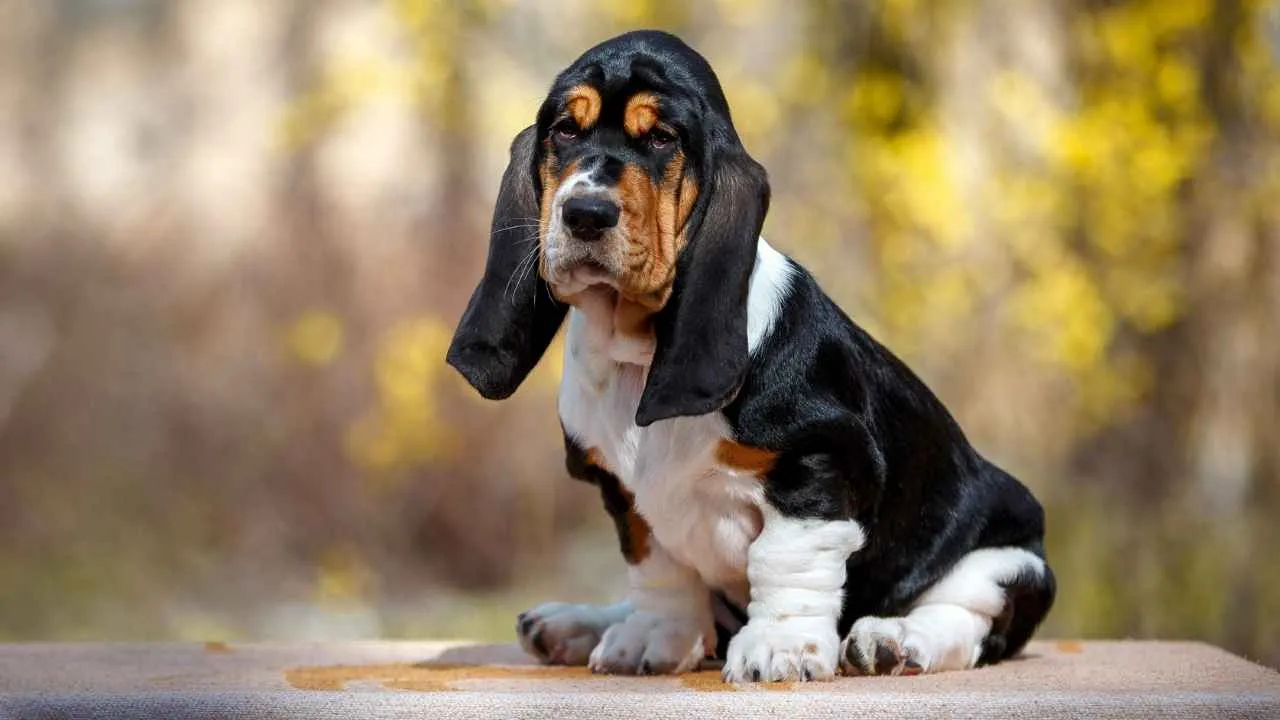
Originally bred in France for aristocratic hunting parties, the Basset Hound is a scent-tracking superstar with a lovable, laid-back personality. Recognized by the AKC in 1885, this long-eared breed is best known for its unmatched nose, second only to the Bloodhound.
Their low-to-the-ground stature is where the breed takes its name: basset is French for “short” or “low-set.”
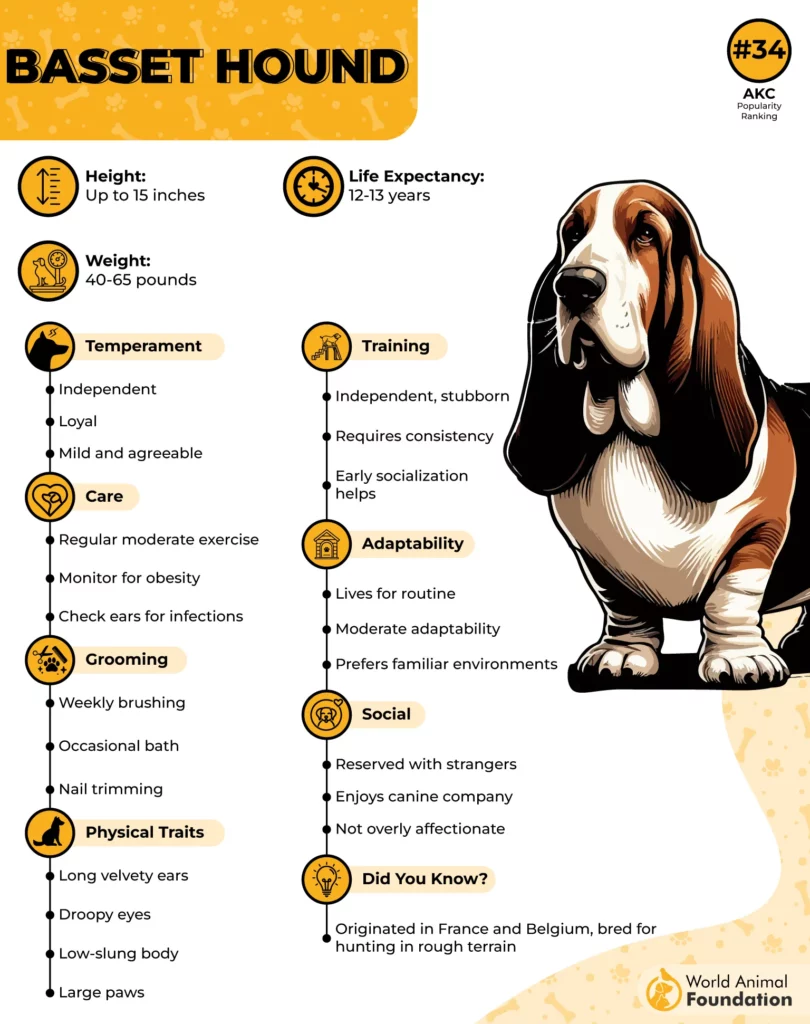
Basset Hounds are known for their loud, baying bark, which they use when excited or frustrated. While training can reduce excessive barking, complete silence is unlikely.
Their powerful sense of smell and proximity to the ground make them prone to eating anything they find, which can lead to choking, stomach issues, or intestinal blockages. Signs like vomiting, diarrhea, or reduced appetite should be addressed by a vet immediately.
Grooming and Health Needs
Due to their loose skin, drooling, and strong natural odor, Basset Hounds require regular cleaning, especially around the face and ears. They shed heavily in spring and fall, needing daily brushing during those times.
Bassets are also prone to allergies, seborrhea, and recurring skin and ear infections. Watch for signs such as itching, rashes, head shaking, or foul odors. Frequent baths with medicated shampoo and regular ear cleanings are essential to manage and prevent infections.
A Nose for the Job
Purpose-Bred: Used to trail hares, rabbits, deer, and even birds.
Super Scenting Tools:
Long ears stir up scents.
Droopy skin traps and concentrates smell.
Top Competitor: Excels in Scent Work, Tracking, and Field Trials.
4. Bloodhound
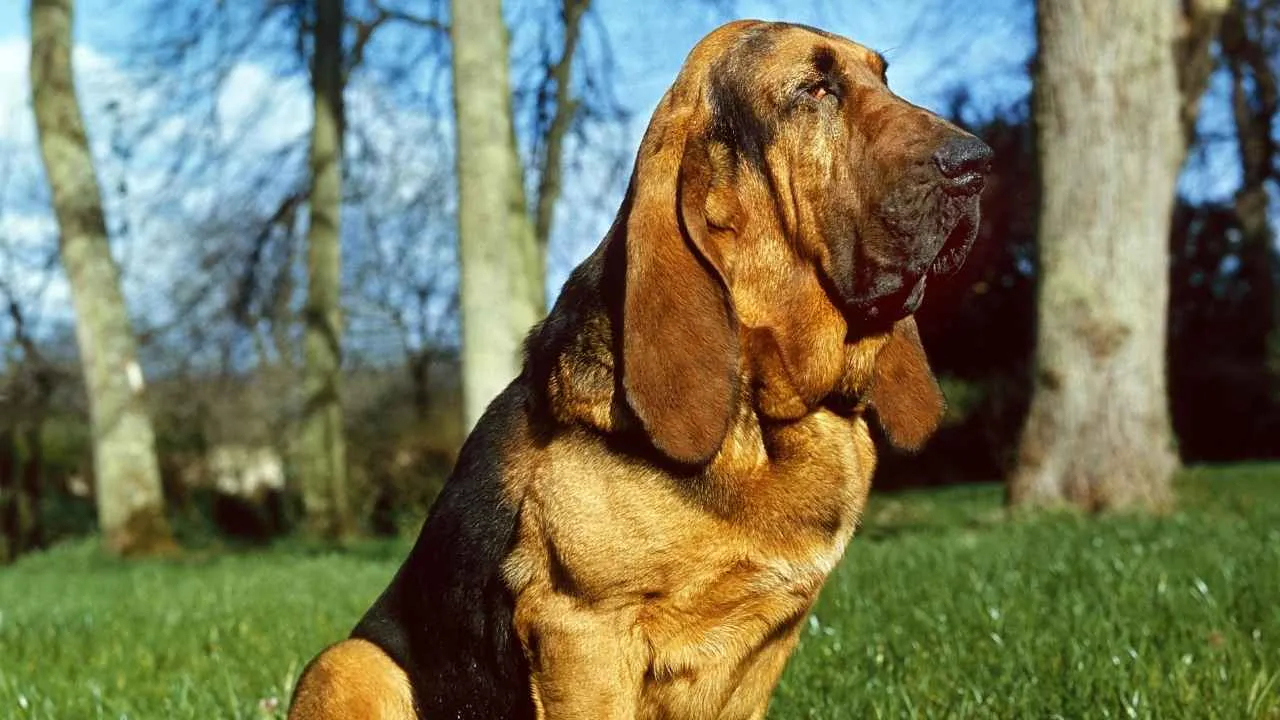
The Bloodhound is one of the oldest scent-hounds in existence, renowned for its unmatched tracking skills and aristocratic roots. Britannica states that with around 230 million scent receptors—40 times more than humans—it’s a legend in the world of scent detection.
The name “Bloodhound” refers to the breed’s noble ancestry, not aggression. Originating from the Saint Hubert Monastery in Belgium, these dogs were refined by monks and bred in honor of St. Hubert, the patron saint of hunters.
Their exceptional tracking skills and dignified presence led to them being gifted to kings and nobles, solidifying their aristocratic reputation. Bloodhounds were later introduced to England in the 11th century, further spreading their esteemed legacy.
Form meets Functionality
Basset Hound’s droopy eyes, loose skin, and long, floppy ears play a key role in its exceptional scent-tracking abilities. The wrinkles around its face and neck aren’t just for show—they help trap scent particles and channel them toward the nose, enhancing the dog’s tracking skills.
Meanwhile, its oversized ears sweep smells up from the ground as it moves. Though their calm, laid-back demeanor may give the impression of laziness, Basset Hounds are intensely focused when following a trail, using every wrinkle and fold to their advantage.
Famous Bloodhounds in History
Two Bloodhounds, Burgho and Barnaby, were called in to assist during the Jack the Ripper investigation.
5. Pug
The Pug is a small, muscular toy dog with a rich history and a face that melts hearts. Known for its loyalty and alertness, the Pug has been a cherished companion for centuries.
Pugs likely originated in China around 400 B.C. and were cherished as lap dogs by Tibetan Buddhist monks and Chinese emperors.
Pugs are easily recognized by their wrinkly, expressive faces, featuring a short muzzle, large, dark eyes, and deep facial folds that give them their signature charm. Their square, muscular build and tightly curled tail add to their distinctive look. With their short, glossy coats—available in colors like black, silver, or apricot fawn with a trademark black mask—Pugs are known to shed heavily.
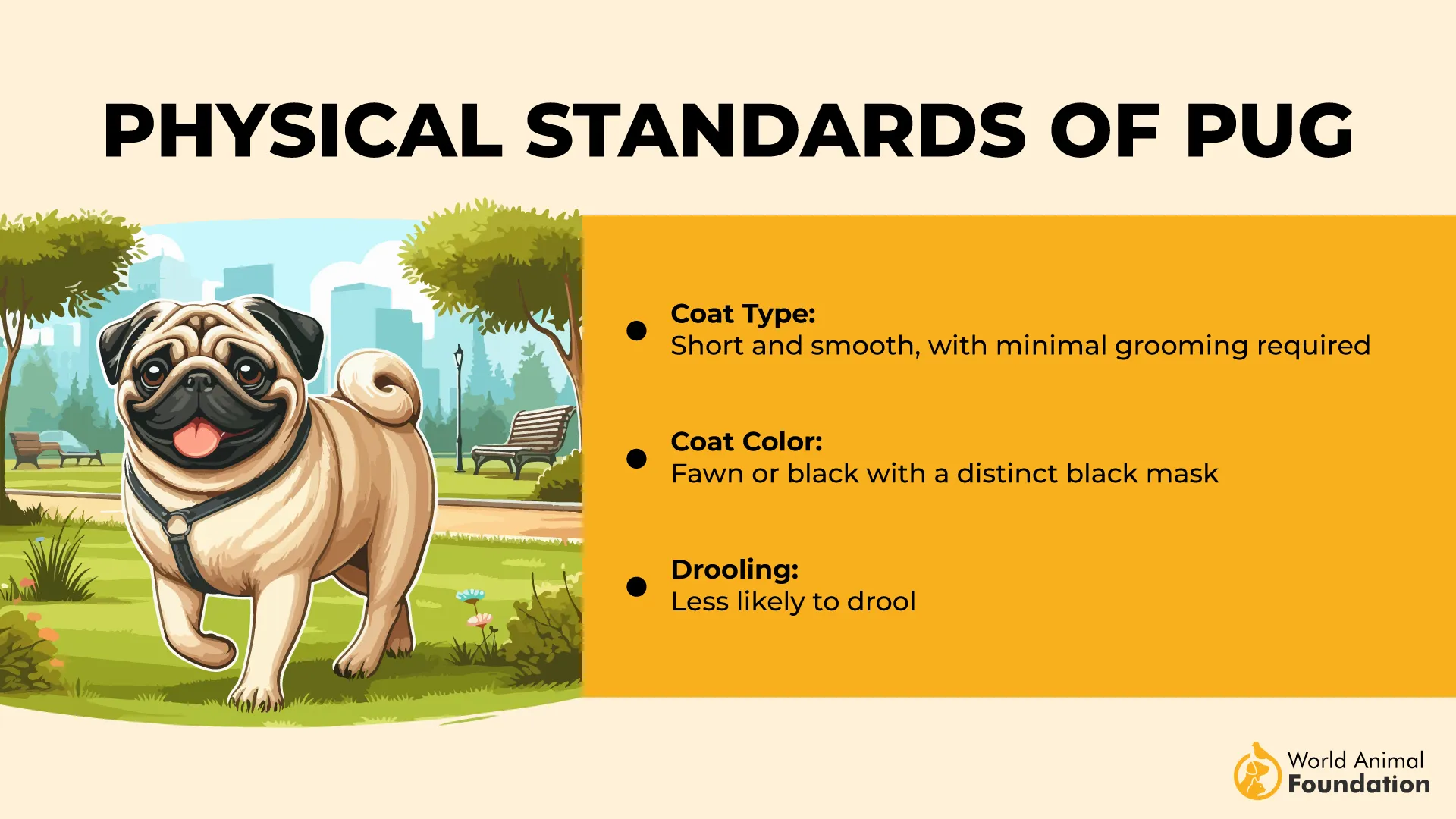
As noted by PDSA, their skin folds require special attention, as moisture trapped in these wrinkles can lead to bacterial or fungal infections if not properly cleaned and dried.
The Story behind Pug’s Wrinkly Face
Pugs’ distinctive facial wrinkles are not just a quirky feature; they were intentionally bred to resemble the Chinese character for “prince,” giving them a regal and dignified appearance. These deep, expressive folds on their faces have become a true badge of honor, symbolizing the breed’s ancient ties to Chinese royalty and nobility.
It’s believed that their facial features, particularly the wrinkled muzzle and large, dark eyes, inspired their name, which may derive from the term “Pug monkey.” This reference highlights their playful, mischievous charm.
6. Dogue de Bordeaux
The Dogue de Bordeaux, also known as the Bordeaux Mastiff or French Mastiff, is a large and powerful breed with a history rooted in France. While their imposing appearance makes them a favorite among dog lovers, their distinctive features can lead to health challenges. Originating in France, Dogue de Bordeaux was used for guarding estates, protecting livestock, and hunting large game.
This large and muscular breed is known for its distinctive wrinkled appearance. With a broad head, deep forehead wrinkles, and prominent facial folds, this breed’s signature look requires regular maintenance to ensure its health.
The loose skin around their face can trap moisture, creating an ideal environment for skin infections like dermatitis. Therefore, it’s essential to clean these deep folds regularly to prevent irritation and infection.
Furthermore, they are prone to excessive drooling, especially after meals, so owners should be prepared to wipe down their loose jowls and folds frequently with a damp cloth to maintain hygiene.
Thankfully, the breed’s short, dense coat is relatively low maintenance, shedding minimally, which simplifies grooming. Regular ear cleaning is also recommended, as the breed is prone to ear infections, and maintaining a consistent cleaning routine is crucial for their overall well-being.
Training & Temperament
Calm Yet Stubborn: Known for their calm temperament, but can be stubborn.
Early socialization and positive reinforcement techniques from an early age are the keys.
Training may be challenging due to their self-confidence.
7. French Bulldog
The French Bulldog is a small, muscular dog with a distinctive appearance—miniaturized Bulldog traits, large bat-like ears, and a cheerful personality. Despite their small size, Frenchies are sturdy and strong.
The French Bulldog, often nicknamed the “Frenchie,” was developed in France in the late 1800s through crosses between small Bulldogs and local native dogs.
Temperament and Training
Playful & Affectionate: Known for their joyful, clownish nature. French Bulldogs are both energetic and love to relax.
Great Companions: Great for the elderly and families with children, as long as exercise and heat tolerance are considered.
Stubbornness: While friendly, they can be a bit stubborn, requiring patience during training.
Health Considerations
As noted by PetMD, French Bulldogs are a brachycephalic breed and are prone to specific health concerns:
Breathing Issues: Prone to BOAS (Brachycephalic Obstructive Airway Syndrome), which causes breathing difficulties. This is caused due to their elongated soft palate and narrow nostrils and may require corrective surgery.
Hip Dysplasia: Although small, they are still susceptible to this condition.
C-sections: Often necessary for safe births due to their physical structure.
Famous Connection
A French Bulldog named Gamin de Pycombe was aboard the Titanic with his owner, Robert Williams Daniel.
8. Chow Chow
The Chow Chow is one of the oldest dog breeds, known for its lion-like mane, blue-black tongue, and stiff-legged walk. Originally from ancient China, this breed combines a regal appearance with a unique and independent nature.
A Distinctive Trait
One of the most distinctive and iconic features of the Chow Chow is its blue-black tongue, a trait it shares with only a few other breeds, such as the Chinese Shar-Pei. Chow Chow puppies are typically born with pink tongues, but as they grow, usually by 8 to 10 weeks of age, their tongues darken to a striking blue-black hue.
This pigmentation is considered a hallmark of the breed and is often used as a key identifier in breed standards. The origin of this unique feature is not fully understood, but it adds to Chow’s mystique and ancient lineage. If a Chow’s tongue remains pink into adulthood or develops light patches, it may be a sign of a health issue or that the dog isn’t a purebred, so it’s always worth consulting a veterinarian for clarity.
Personality & Behavior
Independent & Stubborn: Petplan states Chow Chows are known for their independence and can be difficult to train.
Low-Energy: As adults, they are not particularly playful but enjoy bouts of private comedy and often sit on their owners’ feet.
Aloof Nature: They tend to be reserved, aloof toward strangers, and may even be aggressive if not properly trained.
Loyal but Not Affectionate: While not overly affectionate, they are extremely loyal to their family.
Great Watchdog: Excellent at alerting their owners and can also serve as a protection dog.
The Chow Chow is a majestic and loyal companion, perfect for those who appreciate its independent spirit and regal appearance. Ideal for owners who want a low-maintenance, confident dog, the Chow Chow adds a touch of grandeur to any home.
9. Boxer
The Boxer is a medium-sized, muscular dog breed truly captivating with their unique dog’s wrinkles, thick double coats, and droopy ears. The breed is prized for its agility, intelligence, and boundless energy. Originating from Germany and imported to the U.S. in the 1930s, Boxers are playful, athletic dogs with a natural affection for their families.
Boxers are intelligent, energetic, and affectionate dogs with a playful spirit and a mind of their own. Their independent nature can make training a bit challenging, often requiring patience and creativity, as they sometimes prefer to do things their own way.
Despite this, they are incredibly loving and protective, especially with children, making them ideal family pets. Known for their high energy, Boxers often greet their loved ones with enthusiasm—sometimes performing their signature “kidney bean dance,” a joyful, twisting display of affection.
Due to their strong bond with humans and intelligence, Boxers excel as service dogs, including roles as guide dogs and seizure-alert dogs.
Interesting Facts About Boxers
The breed’s name comes from their boxer-like sparring style with their front paws.
AKC states that four foundational dogs, including Sigurd, Lustig, Utz, and Dorian, helped shape the American Boxer breed and were nicknamed “the Four Horsemen of Boxerdom”.
The breed has won Best in Show at the prestigious Westminster Kennel Club Dog Show four times.
Conclusion
Wrinkly breeds like the Dogue de Bordeaux, French Bulldog, Chow Chow, and Boxer stand out in the canine world with their imposing presence, huge ears, and thoughtful expressions. Despite their distinctive looks, these dogs are known for their gentle nature and form deep bonds with their families, making them fantastic companions.
While they may not be as agile as other breeds, their protective nature and loyalty make them excellent companion dogs. Whether it’s a Pekingese dog or a playful Boxer, these playful pups bring joy and affection.
However, due to their wrinkled skin and potential difficulty breathing, they require proper socialization and care. With their unique looks and strong personalities, these breeds remain beloved for their charm, loyalty, and the unique character they bring to the family.


